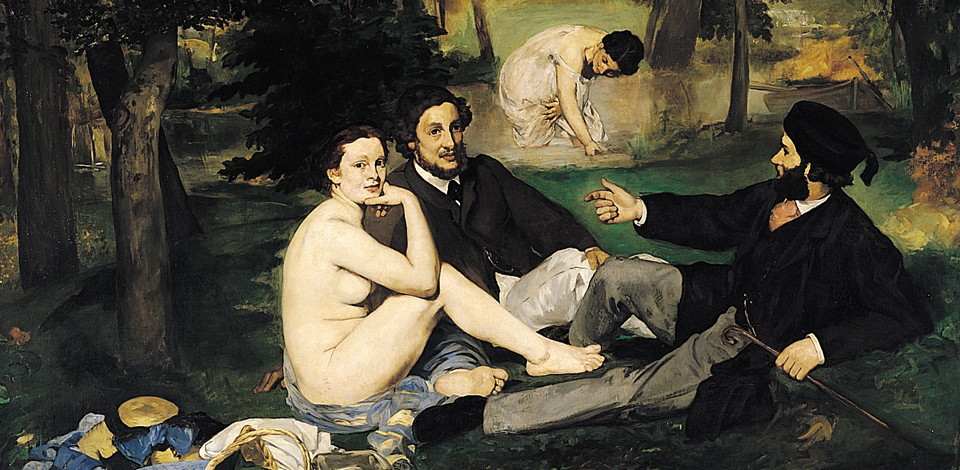“You would hardly believe how difficult it is to place a figure alone on a canvas, and to concentrate all the interest on this single and universal figure and still keep it living and real.”
Edouard Manet’s Le déjeuner sur l’herbe belongs to a well-known genre of French paintings of the middle to late 19th century depicting people of all classes relaxing in the parks or the countryside, often by a body of water. The Luncheon on the Grass, as it’s known in English, was painted in 1862 —63 and exhibited that same year at the Salons des Refusés, a non-mainstream exhibition space in Paris for works of art falling outside the requirements of the traditional Salon. The controversy seen in this painting at the time was caused by the nude, or to be precise, by the context within which Manet depicted her. The nude looking at you is not a nymph, goddess or any other mythological creature. She is a real modern woman who took her clothes off (you can clearly see two sleeves of her light blue polka-dot dress and her hat to the left of her) and is sitting with two fully dressed middle class men in a rural landscape! She is not ashamed of being naked as she gazes confidently at us. The two men sitting next to her seem to accept her nudity with proper respect and none of them is looking directly at her. Manet would further exploit the difference between “nudity” and “nakedness” in his famous and infamous Olympia
See Egon Schiele’s Sitting Nude with Yellow Blanket.
All of the sitters and the woman in the background were real individuals. The model, probably for both of the female figures, was Victorine Meurent, who appeared frequently in other Manet’s paintings (most famously in Olympia, painted the same year). The man on the left is Ferdinand Leenhof, Manet’s brother in law, and the man on the right is the painter’s younger brother Eugene Manet. The fact that all of the individuals were recognizable and were depicted in an explicit narrative made this work impossible to exhibit along with traditional paintings approved by The French Academy.
See Manet’s breathtaking portrait of Irma Brunner.
What is also interesting about this work that caused such a controversy among the French society, is that, despite the contemporary setting of The Luncheon on the Grass, the composition was almost entirely borrowed from Raphael’s Judgment of Paris engraving (ca. 1510 − 1520). Manet echoed every detail of gestures and poses of Raphael’s sitters, seen on the bottom right corner. The only exceptions are the additional female figure seen in the background and the pose of the middle male figure. In Raphael’s busy composition he is looking away to his left, and Manet’s relaxed, yet scandalous setting the man is gazing between the viewer and the second man in the painting. In Raphael’s work, which is permeated by nudity, its mythological narrative made it socially acceptable for Manet’s contemporaries, while The Luncheon showing only a single nude and explicitly assuming her sexuality reinvented modernist pictorial traditions and became hugely inspirational to young artists.
This article © galleryIntell.
Image Paris, Musée d’OrsayEtienne Moreau Nélaton donation, 1906 © RMN -Grand Palais(Musée d’Orsay) / Hervé Lewandowski


















